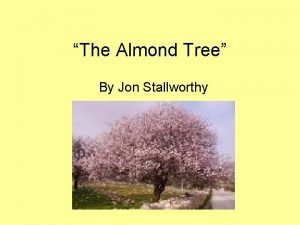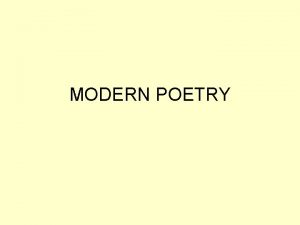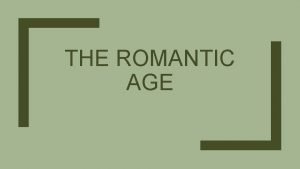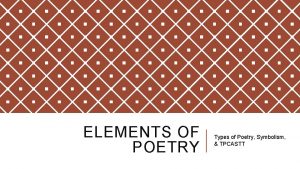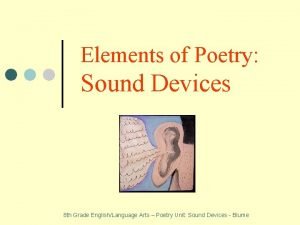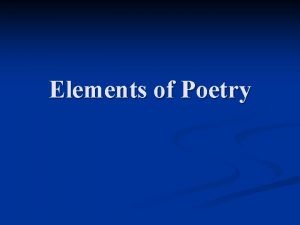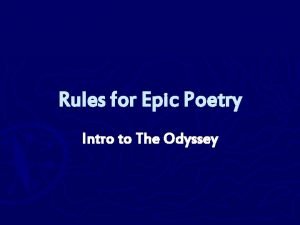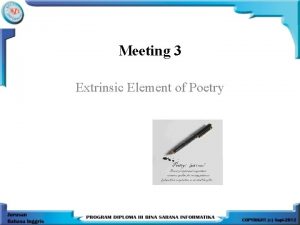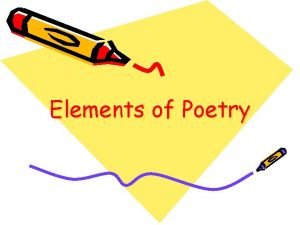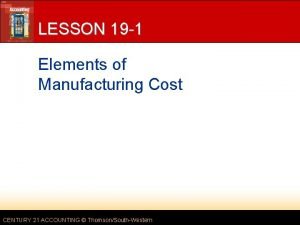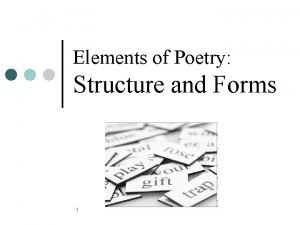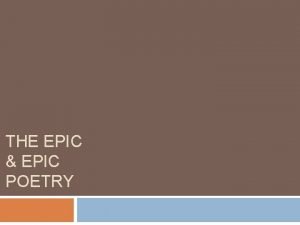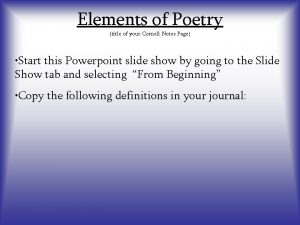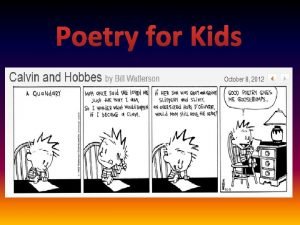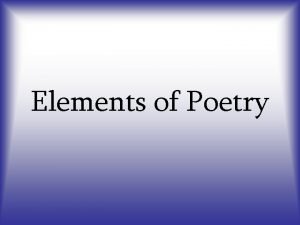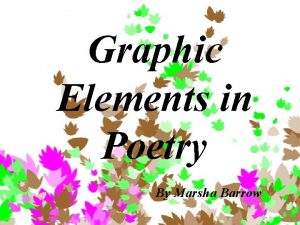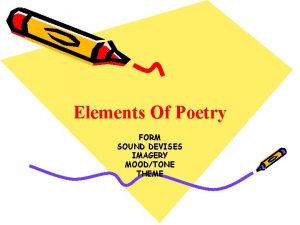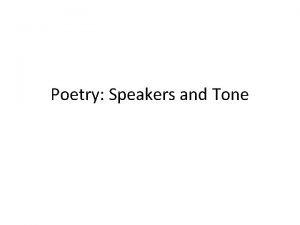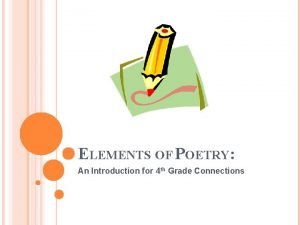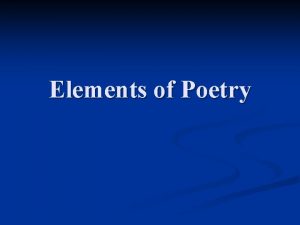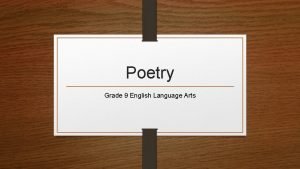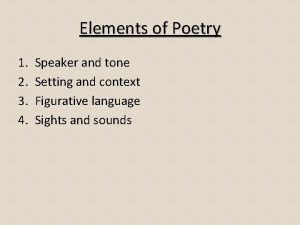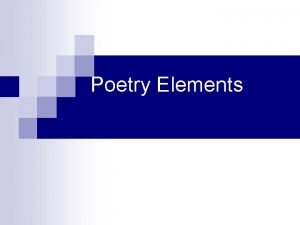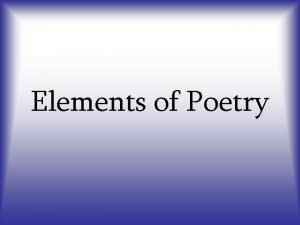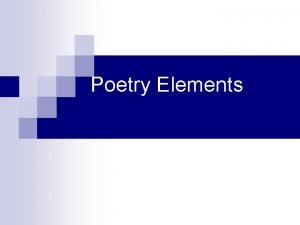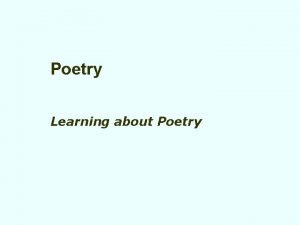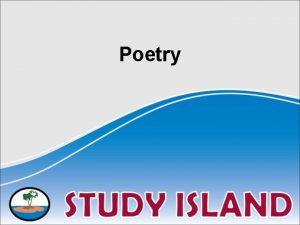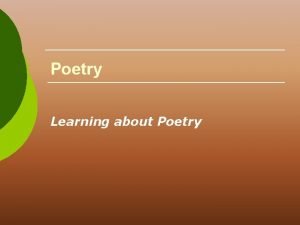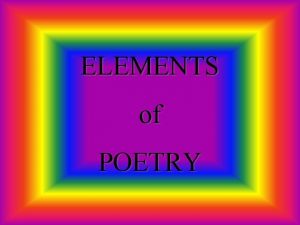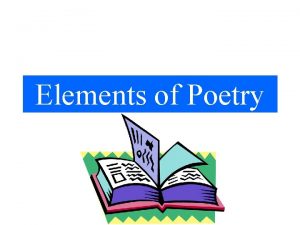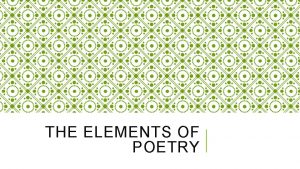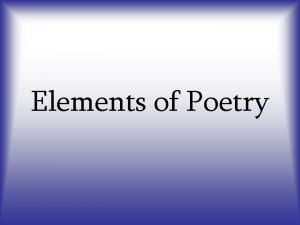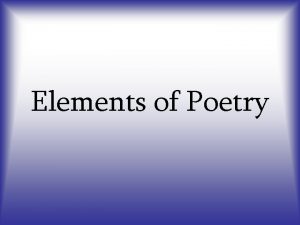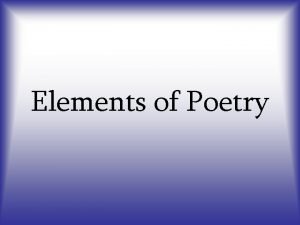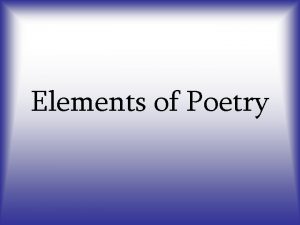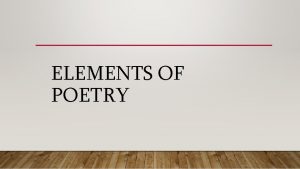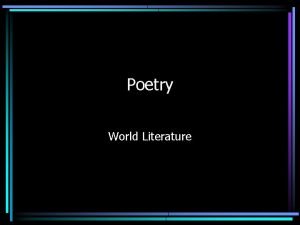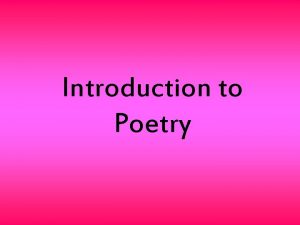Elements of Poetry Elements of Poetry What is





























- Slides: 29

Elements of Poetry

Elements of Poetry • What is poetry? • Poetry is not prose. Prose is the ordinary language people use in speaking or writing. • Poetry is a form of literary expression that captures intense experiences or creative perceptions of the world in a musical language. • Basically, if prose is like talking, poetry is like singing. • By looking at the set up of a poem, you can see the difference between prose and poetry.

Distinguishing Characteristics of Poetry • Unlike prose which has a narrator, poetry has a speaker. – A speaker, or voice, talks to the reader. The speaker is not necessarily the poet. It can also be a fictional person, an animal or even a thing Example But believe me, son. I want to be what I used to be when I was like you. from “Once Upon a Time” by Gabriel Okara

Distinguishing Characteristics of Poetry • Poetry is also formatted differently from prose. – A line is a word or row of words that may or may not form a complete sentence. – A stanza is a group of lines forming a unit. The stanzas in a poem are separated by a space. Example Open it. Go ahead, it won’t bite. Well…maybe a little. from “The First Book” by Rita Dove

Figures of Speech • A figure of speech is a word or expression that is not meant to be read literally. • A simile is a figure of speech using a word such as like or as to compare seemingly unlike things. Example Does it stink like rotten meat? from “Harlem” by Langston Hughes

Figures of Speech • A metaphor also compares seemingly unlike things, but does not use like or as. Example the moon is a white sliver from “I Am Singing Now” by Luci Tapahonso • Personification attributes human like characteristics to an animal, object, or idea. Example A Spider sewed at Night from “A Spider sewed at Night” by Emily Dickinson

Figures of Speech • Hyperbole – a figure of speech in which great exaggeration is used for emphasis or humorous effect. Example “You’ve asked me a million times!” • Imagery is descriptive language that applies to the senses – sight, sound, touch, taste, or smell. Some images appeal to more than one sense.

Sound Devices • Alliteration is the repetition of consonant sounds at the beginning of words. • Assonance is the repetition of vowel sounds within a line of poetry. • Onomatopoeia is the use of a word or phrase, such as “hiss” or “buzz” that imitates or suggests the sound of what it describes.

Example of Sound Devices “In the steamer is the trout seasoned with slivers of ginger” from “Eating Together” by Li-Young Lee And the stars never rise but I see the bright eyes from “Annabel Lee” by Edgar Allan Poe

Rhyme • Rhyme is the repetition of the same stressed vowel sound any succeeding sounds in two or more words. • Internal rhyme occurs within a line of poetry. • End rhyme occurs at the end of lines. • Rhyme scheme is the pattern of end rhymes that may be designated by assigning a different letter of the alphabet to each new rhyme

Example “All mine!" Yertle cried. "Oh, the things I now rule! I'm king of a cow! And I'm king of a mule! I'm king of a house! And what's more, beyond that, I'm king of a blueberry bush and cat! I'm Yertle the Turtle! Oh, marvelous me! For I am the ruler of all that I see!” from “Yertle the Turtle” by Dr. Seuss A A B B C C

“Penelope” by Dorothy Parker A In the pathway of the sun, B In the footsteps of the breeze, Where the world and sky are one, A B He shall ride the silver seas, He shall cut the glittering wave. C D I shall sit at home, and rock; Rise, to heed a neighbor’s knock; D Brew my tea, and snip my thread; E Bleach the linen for my bed. E They will call him brave. C

Near Half Rhyme • Slight or inaccurate repetition of sounds. ( Also called “impure” rhyme. • Examples: 1. On top of the hill The moon is full – ‘hill’ and ‘full’ 2. Give this to the man, He’ll know what I mean. – ‘man’ and ‘mean’

Eye Rhyme • Words that look like they rhyme ( similar spelling), but do not rhyme. = sight rhyme • Examples: Listen to the water flow, From top I don’t see how. – ‘flow’ and ‘how’ When the game is over, a true champion we’ll discover. _ ‘over’ and ‘discover’.

Irony • • Saying the opposite of what you actually mean. Examples: 1. Water, water everywhere, but a drop to drink. 2. The directions were as clear as mud. ( this last one s also a simile)

Paradox • A statement that seems to contradict or oppose itself, yet actually reveals some truth. • It’s hard work doing nothing. • The more we know, the less we understand. • The less you have, the less you are free.

Connotation and Denotation Connotation - the emotional and imaginative association surrounding a word. Denotation - the strict dictionary meaning of a word. Example: You may live in a house, but we live in a home.

Which of the following has a more favorable connotation? thrifty penny-pinching pushy aggressive politician statesman chef cook slender skinny

Elements of Poetry When we explore the connotation and denotation of a poem, we are looking at the poet’s diction. Diction – the choice of words by an author or poet. Many times, a poet’s diction can help unlock the tone or mood of the poem.

Elements of Poetry: Tone and Mood Although many times we use the words mood and tone interchangeably, they do not necessarily mean the same thing. Mood – the feeling or atmosphere that a poet creates. Mood can suggest an emotion (ex. “excited”) or the quality of a setting (ex. “calm”, “somber”) In a poem, mood can be established through word choice, line length, rhythm, etc. Tone – a reflection of the poet’s attitude toward the subject of a poem. Tone can be serious, sarcastic, humorous, etc.

Narrative Poetry • Narrative poetry is verse that tells a story. • Two of the major examples of narrative poetry include: – Ballads – a song or poem that tells a story. Folk ballads, which typically tell of an exciting or dramatic event, were composed by an anonymous singer or author and passed on by word of mouth for generations before written down. Literary ballads are written in imitation of folk ballads, but usually given an author. – Epics – a long narrative poem on a great and serious subject that is centered on the actions of a heroic figure

Dramatic Poetry • Dramatic poetry is poetry in which one or more characters speak. – Each speaker always addresses a specific listener. – This listener may be silent (but identifiable), or the listener may be another character who speaks in reply. – Usually the conflict that the speaker is involved with is either an intense or emotional.

Lyric Poetry • Lyric poetry is poetry that expresses a speaker’s personal thoughts and feelings. – Lyric poems are usually short and musical. – This broad category covers many poetic types and styles, including haikus, sonnets, free verse and many others.

Haikus • The traditional Japanese haiku is an unrhymed poem that contains exactly 17 syllables, arranged in 3 lines of 5, 7, 5 syllables each. • However, when poems written in Japanese are translated into another language, this pattern is often lost. • The purpose of a haiku is to capture a flash of insight that occurs during a solitary observation of nature.

Examples of Haikus Since morning glories hold my well-bucket hostage I beg for water - Chiyo-ni First autumn morning: the mirror I stare into shows my father’s face. - Kijo Murakami

Sonnets • Background of Sonnets – Form invented in Italy. – Most if not all of Shakespeare’s sonnets are about love or a theme related to love. – Sonnets are usually written in a series with each sonnet a continuous subject to the next. (Sequels in movies)

Structure of Sonnets The traditional Elizabethan or Shakespearean sonnet consists of fourteen lines, made up of three quatrains (stanzas of 4 lines each) and a final couplet (two line stanza). The quatrains traditionally follow an abab rhyme scheme, followed by a rhyming couplet.

Free Verse • Free verse is poetry that has no fixed pattern of meter, rhyme, line length, or stanza arrangement. • When writing free verse, a poet is free to vary the poetic elements to emphasize an idea or create a tone. • In writing free verse, a poet may choose to use repetition or similar grammatical structures to emphasize and unify the ideas in the poem.

Example of Free Verse The lunatic is carried at last to the asylum a confirmed case, He will never sleep any more as he did it in the cot in his mother’s bedroom; The dour printer with gray head and gaunt jaws works at his case, He turns is quid of tobacco, his eyes blurred with the manuscript; The malformed limbs are tied to the anatomist’s table, What is removed drops horribly in the pail; The quadroon girl is sold at the stand…. the drunkard nods by the barroom stove… Excerpt from “Song of Myself” (section 15) Walt Whitman
 Poetry poetry
Poetry poetry Experimentation in modern poetry
Experimentation in modern poetry Famous lyrical poems
Famous lyrical poems Augustan poetry aim
Augustan poetry aim Cavalier poetry definition
Cavalier poetry definition Elements of poetry symbolism
Elements of poetry symbolism Poetry elements
Poetry elements Which poetry element affects the poem's sound?
Which poetry element affects the poem's sound? Theme elements of poetry
Theme elements of poetry The odyssey and epic poetry: an introduction, part 1
The odyssey and epic poetry: an introduction, part 1 Extrinsic elements
Extrinsic elements What is poetry in literature
What is poetry in literature Elements of poetry lesson 19
Elements of poetry lesson 19 Cinquain poem ideas
Cinquain poem ideas Praepositio in the odyssey
Praepositio in the odyssey What is the pattern of rhyme?
What is the pattern of rhyme? Types of poems kids
Types of poems kids Elements of poetry
Elements of poetry The elements of poetry
The elements of poetry Graphical elements in poetry examples
Graphical elements in poetry examples Elements of poetry mood
Elements of poetry mood Speaker definition poetry
Speaker definition poetry Elements of poetry
Elements of poetry There once was an ape in a zoo limerick
There once was an ape in a zoo limerick Synecdoche figurative language definition
Synecdoche figurative language definition Elements of poetry grade 9
Elements of poetry grade 9 Speaker elements of poetry
Speaker elements of poetry Poetry features
Poetry features Elements of poetry
Elements of poetry Spoken word poetry allows you to be anyone you want to be
Spoken word poetry allows you to be anyone you want to be
